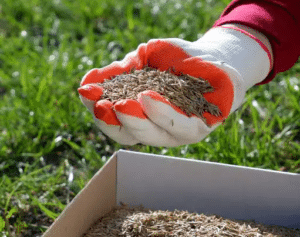Overseeding in Spring: Best Practices for a Thicker Lawn

It’s no surprise that overseeding in the spring seems like the right thing to do. Spring is when everything else starts growing—trees bud, flowers bloom, and the grass starts waking up. It feels like the right time to plant a new seed.
But in Central Indiana, that feeling is misleading. And if you want a thicker, healthier lawn that lasts, spring overseeding is probably the worst move you can make.
Here’s why.
The Spring Seeding Trap: What the Big Box Stores Don’t Tell You
When you plant grass seed in the spring, you might get some early growth. That’s the bait. But what most homeowners don’t realize is that your grass is about to enter a battle it can’t win—against weeds and summer stress.
Here’s what’s working against your new grass:
_______________________________________________________________________________________________________________
1. You Can’t Use Weed Control
If you’re seeding in the spring, forget about using any weed prevention.
That’s right—no pre-emergents, no post-emergents, no crabgrass control, no dandelion killer. For at least 60 days, you can’t apply weed control because it will kill your baby grass.
So now you’re trying to grow delicate grass seedlings at the same time weeds are exploding out of the soil.
Spoiler alert: the weeds win.
________________________________________________________________________________________________________________
2. Summer Stress Is a Death Sentence
Even if your new grass seed manages to germinate (which it might), it won’t have enough time to establish deep roots before the heat of summer kicks in.
And here in Central Indiana, we don’t just get warm summers—we get hot, dry ones. Most lawns go dormant in July and August. Established turf can survive this. Young spring-seeded grass? Not a chance.
That tender green lawn you saw in May? By August, 80–90% of it is gone. Dried up, burned out, or just overtaken by weeds.
________________________________________________________________________________________________________________
3. You’ll Just Pay Double
Most homeowners who seed in the spring end up calling us in the fall to re-do it all over again. That means double the cost, double the work, and double the frustration.
_________________________________________________________________________________________________________________
So When Should You Overseed?
Fall is the absolute best time to seed your lawn in Indiana.
Here’s why:
– Weeds start to die off, so grass doesn’t have to compete as hard.
– Soil temps are still warm, which is great for germination.
– Cooler air temperatures and more frequent rain* create the perfect environment for new grass to grow deep roots.
– And here’s the kicker: Your grass gets nearly a full year before it faces its first summer.
That means by the time July rolls around, that fall-seeded lawn is strong, established, and ready to handle the heat.
__________________________________________________________________________________________________________________
But What If I Have to Seed in Spring?
There are a few edge cases where spring seeding might make sense. If you’ve had construction damage, bare spots from pets, or a complete lawn renovation that can’t wait, there are ways to make spring seeding less terrible. (Notice we didn’t say “great.”)Spring Overseeding Best Practices:
– Choose high-quality seed tailored for Indiana soil and climate.– Skip the weed control products—yes, all of them.
– Water consistently and lightly every day.
– Mow high to protect seedlings.
– Plan to seed again in the fall. (Seriously.)
__________________________________________________________________________________________________________________
The Takeaway: Wait for Fall, Thank Yourself Later
Spring overseeding is a tempting shortcut—but in most cases, it leads to disappointment. At Blue Duck Lawn Care, we believe in doing things right the first time, not just chasing seasonal marketing hype.So if you’re thinking about throwing seed down this spring, give us a call first. We’ll talk through your lawn’s condition and help you plan a smarter, long-term solution—so your lawn is thick, healthy, and built to last.